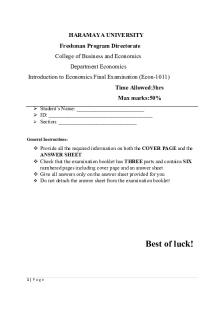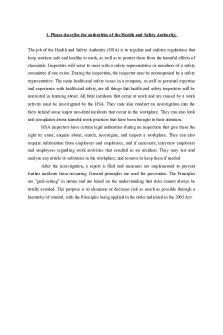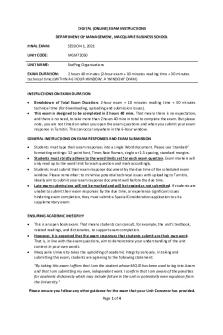FS final exam 2021 Edited PDF

| Title | FS final exam 2021 Edited |
|---|---|
| Author | Urgessa Firomsa |
| Course | Introduction to economics |
| Institution | Haramaya University |
| Pages | 6 |
| File Size | 199.5 KB |
| File Type | |
| Total Downloads | 4 |
| Total Views | 153 |
Summary
EXAM...
Description
HARAMAYA UNIVERSITY Freshman Program Directorate College of Business and Economics Department Economics Introduction to Economics Final Examination (Econ-1011) Time Allowed:3hrs Max marks:50% ➢ Student`s Name: __________________________ ➢ ID: ________________________________________ ➢ Section: ___________________________________ General Instructions:
❖ Provide all the required information on both the COVER PAGE and the ANSWER SHEET ❖ Check that the examination booklet has THREE parts and contains SIX numbered pages including cover page and an answer sheet ❖ Give all answers only on the answer sheet provided for you ❖ Do not detach the answer sheet from the examination booklet !
Best of luck!
1|P age
PART I: Say True if the statement is correct or False if the statement is incorrect (1.5 each) 1. If implicit costs exist, the accounting profit will be larger than economic profit. 2. If the average cost is greater than the market price at equilibrium, the firm earns a positive profit. 3. The demand curve of the firm under perfect competition is downward sloping. 4. Indifference curve is a line representing different combinations of two goods that a consumer can buy with a given income at a given prices level. 5. The stage of production in which all TP, AP and MP of labour increases is called stage one. PART II: Choose the best answer from the given alternatives (1.5 each) 6) Which one of the following is not an assumptions of cardinal utility approach? A. Rationality of consumers. B. Diminishing marginal utility C. Diminishing marginal rate of substitutions D. Constant marginal utility of money 7) Marginal utility implies; A. The maximum level of satisfaction derived from consuming goods and services B. The additional level of satisfaction derived from consuming one more unit of product C. The changes come to total utility due to change in the price of product D. The total level of satisfaction derived from consuming all the goods and services available in the consumers basket 8) Identify the wrong statement? A. Monopolistic competition is the mixture of perfectly competitive and monopoly B. Oligopoly is the market of single seller C. There is no distinction between firm and industry under monopoly D. In perfect competition average revenue and price are identical 9) An oligopolistic industry is characterized by all of the following except; A. Firms are independent B. Economies of scale C. Homogenous product D. Has significant barrier to entry 10) When the short-run average product of labour is declining but positive, the marginal product of labour is: A. Negative
C. Zero
B. Declining
D. Any of these is possible
2|P age
11) Which one is true, if price of a firm is given as P = 100 – 0.05Q? A. Total revenue (TR) function of firm will be; 100Q – 0.05Q2 B. Marginal revenue (MR) function of firm will be; 100 – 0.1Q C. Total revenue (TR) is maximized at 1000 unit of output D. All of the above are correct 12) A firm operating in a perfect market maximize its profit by adjusting: A. It’s output price until it exceeds average total cost as much as possible. B. Its output price until it exceeds marginal cos as much as possible C. It’s output until its marginal cost equals output price D. It’s output until its average total cost is decreasing 13) Average variable cost and average total cost get closer together as output increase because? A. Marginal cost decrease as output increase B. Diminishing return set in C. Economies of scale become apparent D. Average fixed cost fall as produced output increase 14) Which of the following argument does explain the consumers equilibrium in the single commodity case? A. The ratio of the marginal utility associated with the last unit of each good consumed to the price of the good is equal for all goods consumed B. The ratio of the total utility associated with each good consumed to the price of the good is equal for all goods consumed C. Marginal utility associated with the good consumed is equal with the given price of the commodity consumed D. The total utility associated with each good consumed is equal for all goods consumed. 15) Total product will decrease as more of variable factor is added to the production process only if? A. Marginal product is decreasing B. Marginal Product is zero C. Marginal Product is negative D. Marginal cost of variable factor is minimum 16) Which of the following can best describe the situation when marginal utility (MU) becomes negative? A. Additional consumption of the product adds more satisfaction B. The consumer is dissatisfied C. Total utility of a good is maximized D. The consumer is in equilibrium
3|P age
17) Suppose a consumer has birr100 to spend on two goods, shoes and shirts. If the price of a pair of shoes is birr 20 per pair and the price of a shirt is birr 15 each, which of the following combinations is unaffordable to the consumer? A. 0 pairs of shoes and 4 shirts B. 2 pairs of shoes and 2 shirts C. 5 pairs of shoes and 0 shirts D. 0 pairs of shoes and 8 shirts E. 2 pairs of shoes and 3 shirts 18) When the short run average product is at its maximum all can be occurred except: A. Total product is increasing B. Marginal product is positive C. It is equal to the marginal product D. Average cost is minimum 19) For a monopoly firm, which of the following equalities is always true at equilibrium? A. Price = average revenue B. Price = marginal revenue C. Price = total revenue D. Marginal revenue = marginal cost 20) What is the difference between perfect competition and monopolistic competition? A. Perfect competition has a large number of small firms while monopolistic competition does not. B. In perfect competition, firms produce identical goods, while in monopolistic competition, firms produce slightly different goods. C. Perfect competition has no barriers to entry, while monopolistic competition does. D. Perfect competition has barriers to entry while monopolistic competition does not. 21) Perfectly competitive firms are price takers because A. Each firm is very large B. There are no good substitutes for their goods C. Many other firms produce identical products. D. Their demand curves are downward sloping E. None of the above 22) What will happen, if market price is less than the minimum value of AVC in perfect competitive market? A. The firm start operating the business B. The firm will keep the operation C. The firm should close the business D. All of the above
4|P age
PART III: Workout and discussion questions (keep the necessary steps) 23) Given the utility function U (x, y) = 𝒙𝟎.𝟔𝟓𝑦 𝟎.𝟐𝟓 and the Px = 8, Py=5 and Income(I) = 80, then: A. Calculate maximum utility (2.pts) B. Find the MRSxy at equilibrium and interpret it (2.pts) 1 24) Perfectly competitive firm has short run TC = Q3-5Q2+41Q+100 and market price birr 80 3
per unit A. Calculate short run quantity should producer supply and profit the firm (2.pts) B. What is the shut-down point? And What level of price required for the firm to stay in the market? (2.pts) C. Find the minimum value of MC and ATC (2.pts) 25) Show both mathematically and graphically the inverse relationships between average product and marginal product of labor on the one hand and the average variable cost and marginal cost on the other hand in short run period of production (2.pts) 26) In perfect competitive market P=AR=MR=demand curve, proof it by using the necessary steps and assumptions! (1.pts) 27) Given: Labor(L) = 8 and Wage rate (W) = 80, AP= 10 and MP=8, if lobar is only the variable; i. Which one is greater, MC or AVC? (1.pt) ii. In which stage of production is the firm? Why? (1.pt) 28) In which conditions firms can get profit, breakeven point, incur loss and shutdown point in perfect competitive market (2.pts)
5|P age
ANSWER SHEET ➢ Student`s Name: _______________________________________ ➢ ID: ___________________________________________________
➢ Section: _______________________________________________
PART I: True or False
1)
2)
3)
4)
5)
PART II: Multiple Choice 6.
7.
8.
9.
10.
11.
12.
13.
14.
15.
16.
17.
18.
19.
20.
21.
22.
PART III: Use the attached white papers for Work out and discussion!
6|P age...
Similar Free PDFs

FS final exam 2021 Edited
- 6 Pages

Semesterprogramm FS 2021
- 1 Pages

Law Final Exam 2021
- 4 Pages

Final Investigatory2 - Edited
- 29 Pages

LAWS2205 2021 Final Exam Paper
- 5 Pages

Final Exam Review - 2021 261
- 3 Pages

Radiology Final Exam Guide 2021
- 2 Pages

FALL 2021 Final EXAM Schedule
- 1 Pages

MGMT2050 - S1 2021 - Final Exam
- 4 Pages

RAPE - edited 2021 - Class notes
- 16 Pages

Airland FS Manual 1 for year 2021
- 29 Pages

Stundenplan 4 Sem FS 2021 Chemie
- 2 Pages

PHI1101 G final exam A Fall 2021
- 8 Pages
Popular Institutions
- Tinajero National High School - Annex
- Politeknik Caltex Riau
- Yokohama City University
- SGT University
- University of Al-Qadisiyah
- Divine Word College of Vigan
- Techniek College Rotterdam
- Universidade de Santiago
- Universiti Teknologi MARA Cawangan Johor Kampus Pasir Gudang
- Poltekkes Kemenkes Yogyakarta
- Baguio City National High School
- Colegio san marcos
- preparatoria uno
- Centro de Bachillerato Tecnológico Industrial y de Servicios No. 107
- Dalian Maritime University
- Quang Trung Secondary School
- Colegio Tecnológico en Informática
- Corporación Regional de Educación Superior
- Grupo CEDVA
- Dar Al Uloom University
- Centro de Estudios Preuniversitarios de la Universidad Nacional de Ingeniería
- 上智大学
- Aakash International School, Nuna Majara
- San Felipe Neri Catholic School
- Kang Chiao International School - New Taipei City
- Misamis Occidental National High School
- Institución Educativa Escuela Normal Juan Ladrilleros
- Kolehiyo ng Pantukan
- Batanes State College
- Instituto Continental
- Sekolah Menengah Kejuruan Kesehatan Kaltara (Tarakan)
- Colegio de La Inmaculada Concepcion - Cebu


